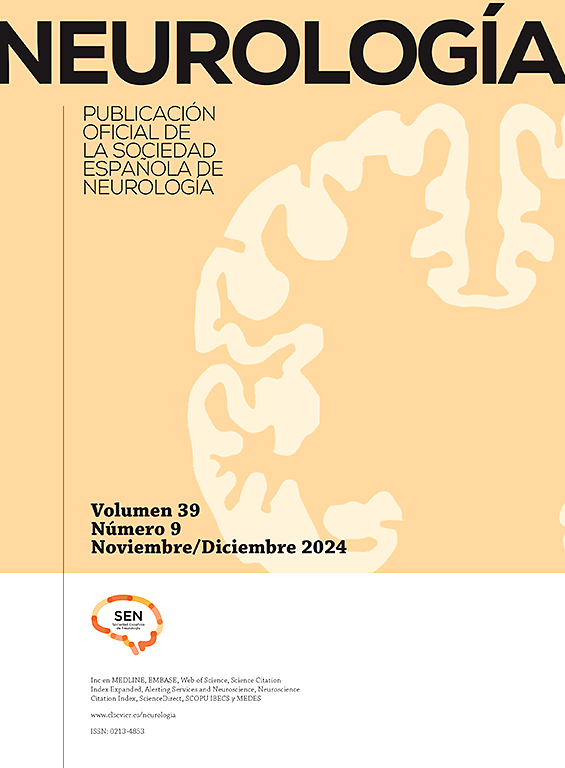Miopatía necrosante inmunomediada: experiencia en una unidad neuromuscular
IF 3.1
4区 医学
Q2 CLINICAL NEUROLOGY
引用次数: 0
Abstract
Objectives
To describe the main features and the clinical management of a cohort of patients with immune-mediated necrotizing myopathy (IMNM).
Methods
We conducted an observational, monocentric, retrospective study of IMNM patients diagnosed in the Neuromuscular Unit of a tertiary hospital in Madrid (Spain) between 2013 and 2021.
Results
Sixteen IMNM cases were diagnosed, with a median age of 71.5 years (range 36-80), 9 of whom (56.3%) were female. Thirteen (81.3%) patients had previously been treated with statins. The time from symptoms onset to diagnosis was less than 6 months in 11 patients (68.8%) and the most common clinical symptoms were proximal weakness and myalgia. The only myositis specific autoantibodies detected were anti-3-hydroxy-3-methyl-coenzyme A reductase in 13 patients. The treatment strategy was based on prednisone, although a combination with other immunosuppressive drugs was required in 8 (50%) patients.
Conclusions
There has been an increase in the diagnosis of immune-mediated necrotizing myopathies in the last few years. The anti-HMGCR antibodies were the only ones detected in this sample, showing their key role in the diagnosis. Early recognition of the disease facilitates to start treatment as soon as possible, which should be based on the initial response to corticosteroids and usually requires a combination of several drugs.
免疫介导坏死性肌病:神经肌肉单位的经验
目的探讨一组免疫介导坏死性肌病(IMNM)患者的主要特征及临床治疗。方法:我们对2013年至2021年间在马德里(西班牙)一家三级医院神经肌肉科诊断的IMNM患者进行了一项观察性、单中心、回顾性研究。结果本组共16例IMNM患者,年龄36 ~ 80岁,中位年龄71.5岁,其中女性9例,占56.3%。13例(81.3%)患者曾接受过他汀类药物治疗。11例(68.8%)患者从症状出现到诊断时间小于6个月,最常见的临床症状为近端无力和肌痛。13例患者肌炎特异性自身抗体仅检测到抗3-羟基-3-甲基辅酶A还原酶。治疗策略以强的松为基础,尽管有8例(50%)患者需要联合使用其他免疫抑制药物。结论近年来,免疫介导的坏死性肌病的诊断率有所上升。该样本中仅检测到抗hmgcr抗体,显示其在诊断中的关键作用。早期识别疾病有助于尽早开始治疗,治疗应基于对皮质类固醇的初始反应,通常需要几种药物的联合使用。
本文章由计算机程序翻译,如有差异,请以英文原文为准。
求助全文
约1分钟内获得全文
求助全文
来源期刊

Neurologia
医学-临床神经学
CiteScore
5.90
自引率
2.60%
发文量
135
审稿时长
48 days
期刊介绍:
Neurología es la revista oficial de la Sociedad Española de Neurología y publica, desde 1986 contribuciones científicas en el campo de la neurología clínica y experimental. Los contenidos de Neurología abarcan desde la neuroepidemiología, la clínica neurológica, la gestión y asistencia neurológica y la terapéutica, a la investigación básica en neurociencias aplicada a la neurología. Las áreas temáticas de la revistas incluyen la neurologia infantil, la neuropsicología, la neurorehabilitación y la neurogeriatría. Los artículos publicados en Neurología siguen un proceso de revisión por doble ciego a fin de que los trabajos sean seleccionados atendiendo a su calidad, originalidad e interés y así estén sometidos a un proceso de mejora. El formato de artículos incluye Editoriales, Originales, Revisiones y Cartas al Editor, Neurología es el vehículo de información científica de reconocida calidad en profesionales interesados en la neurología que utilizan el español, como demuestra su inclusión en los más prestigiosos y selectivos índices bibliográficos del mundo.
 求助内容:
求助内容: 应助结果提醒方式:
应助结果提醒方式:


